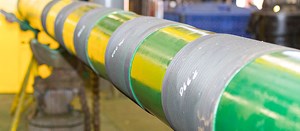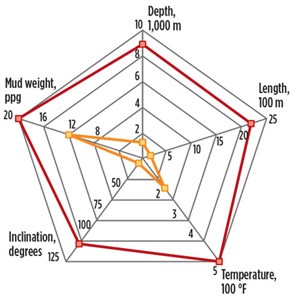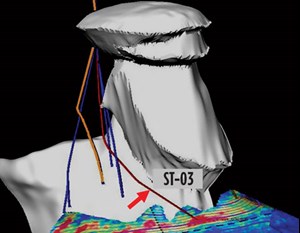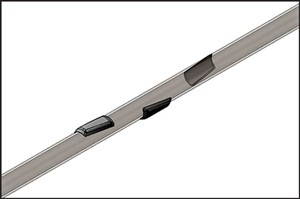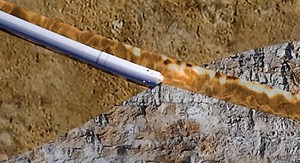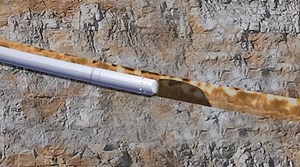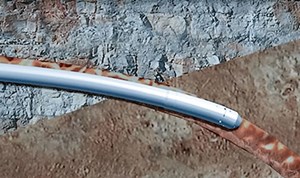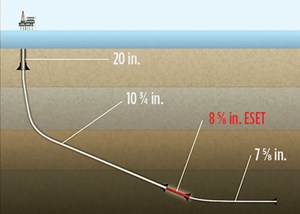Rotating solid expandable liner solves issues in high-angle directional wells
Solid expandable tubulars have been used in oilfield applications for more than 15 years. Initially, they were utilized in vertical boreholes and other non-challenging applications. This led to the perception that expandable systems had limited capabilities, and were not well-suited for use in directional boreholes. Operators were reluctant to experiment with the technology in directional wellbores because of the risk associated with: 1) ledges, due to formation changes; 2) cuttings accumulations on the low side of the wellbore; and 3) tortuosity within the well path, due to intentional trajectory changes.
These problems inherently created by drilling a directional wellbore can lead to significant issues when running the casing string. The combination of these factors can force an operator to remove the casing, and clean the hole section before attempting to rerun the casing. The inefficiency causes non-productive time (NPT) and can result in setting the casing string high. If this happens, an additional casing string of reduced diameter is required to cover the zone to TD, which comprises the project’s economic feasibility.
To help reduce these issues, rotatable solid expandable technology was introduced to maximize casing diameter, manage equivalent circulating density (ECD) and ultimately set tubulars at the planned depth on the first attempt to maximize return on investment.
BACKGROUND
Solid expandable technology (SET) has been installed successfully in vertical and very low-angle directional wellbores since its inception, Fig. 1. Over the last several years, SETs are now regularly installed in more challenging horizontal and extended-reach directional wells. Early use of SET in directional wellbores was intermittent, but now approximately 50% of all SET liners installed are in directional wellbores.
In today’s market, many highly directional wellbores result from a need to explore and develop reserves in the most cost-effective manner. These high-angle boreholes expose trouble zones over a longer hole length. A formation that would have been drilled relatively quickly in a vertical well is left open much longer in a highly inclined directional wellbore. What could have been controlled previously with a simple mud weight increase to stabilize the wellbore while drilling vertically, can now cause significant problems over time, as the formation takes longer to drill and is generally left open for a longer period of time, leading to increased instability. Isolating these formations is a priority to optimize wellbore design, and SET has been applied to accomplish this objective with a minimal loss of casing ID.
DEEPWATER SET APPLICATION
In deep water, the daily cost of operations is exceptionally high. Efficiency and optimization are essential, especially when drilling long, high-angle sidetracks. In one high-profile GOM application, the objective was to reach a new reservoir, utilizing an existing wellbore. After commencing sidetracking operations, difficulties arose when drilling through the depleted zone before reaching the target formation.
Extreme wellbore instability was encountered in the depleted section, which was being drilled at a high angle. Increasing drilling fluid density, to stabilize the wellbore and enable drilling, was not an option. Days of high-cost operations and no progress dictated that the well be plugged back. After changing drilling parameters in a number of areas, a second attempt to drill past the depleted section was initiated; however, days were spent on another unsuccessful attempt once again, ending in another plug-back.
To solve the instability issues, a third sidetrack was designed with a “planned-in” SET liner. The SET liner, in combination with a conventional casing string, was used to successfully isolate the depleted section, enabling fluid density management to allow the well to be drilled successfully to the planned TD, Fig. 2. Since the added casing string was a solid expandable, it enabled the originally planned production casing to be set. ST-03 tapped into a new reservoir, and the well ultimately was brought on production. The discovery justified a full-field development.
ENHANCED SET SYSTEM
The first solid expandable liners were capable of little or no rotation/reciprocation when being run in hole. This was due mainly to the limitation of expansion tools and the increased risk associated with damaging the outside surface of the expandable pipe, which would hinder the expansion process. This situation was addressed by “indexing” a solid expandable liner, in an attempt to mitigate restriction issues in a wellbore. However, this proved unsatisfactory, especially in directional wellbores.
First rotating SET liner system. To enable the efficient use of SET in highly deviated wellbores, an enhanced solid expandable liner system (ESET) was introduced that can be rotated and reciprocated to meet operator objectives and reduce NPT. The technology has expanded the SET operating envelope and reduced the risks associated with ledges, tortuous hole geometry, and increased drag, in long, complex directional wellbores. Rotating the liner is an accepted practice, which can, in these cases, significantly increase the probability of setting the liner at the required depth.
ESET R&D. To develop a commercially viable rotating SET system, an in-depth engineering study was performed to fully understand the tools’ integrate components. First, the expandable pipe was evaluated for torque capability, and it was noted that the best expandable connection available would be needed for rotation. A new type of connection (XPC) had been upgraded recently. In most applications, it would provide triple the torque rating of the original expandable connection. For example, the upgraded XPC connection in an 11¾-in. high-performance SET system, was tested and qualified to 35,000 ft/lb of torque.
Additionally, the inner-string expansion assembly also was reviewed. It was recognized that a simplification of these components would greatly enhance their torque capability and increase the rating of the entire SET system, Fig. 3. The expansion assembly was redesigned to reduce the number of internal connections and increase the torque capability of the assembly. The design now features an elliptical or offset guide nose that will help push the assembly past irregular borehole obstructions, such as ledges.
External coatings. After increasing the system’s torque rating, engineers started testing the external coatings on the expandable pipe. These coatings are an important feature to protect the pipe, if the SET liner is rotated in one position for an extended time. This is a typical occurrence during the displacement of cement, when the liner is rotated without moving the pipe. The coating covers a short section that is positioned at the base of the casing shoe and prevents damage from the metal-on-metal contact. Several coatings were tested that proved to be effective in protecting the expandable pipe. The coatings are applied to the pipe prior to arrival at the rig site.
To improve cementing operations and, therefore, zone isolation, centralization of the rotational liner was reviewed next. Solid centralization has been used with solid expandable liners, and has proven capable for rotational installations with conventional liner systems, Fig. 4. It is available for positive stand-off, utilizing composite and spray metal materials.
SOLVES PROBLEMS
Complex directional wellbores with long tangent sections are challenging to drill, despite the best efforts of well planning. The three issues that are commonly encountered are: ledges, cuttings bed build-up, and wellbore tortuosity. The rotational SET system is designed to solve each of these problems.
Formation changes and ledges. Changes in formation type and formation strength can lead to ledges and an irregular directional wellbore. As the drill bit encounters a harder formation, ROP slows, and this can lead to a wash-out of the softer formation directly above. This situation creates a ledge that successive BHAs must negotiate. A drilling BHA is more flexible than casing or liner strings, and it may appear that the ledge was “wiped out,” only to reappear when casing is being run, causing a hang-up. The ESET system’s eccentric guide nose can be used to help rotate off a ledge enabling a one-way trip to section TD, Fig. 5.
Cuttings build-up. Long tangent sections are common in extended-reach directional wells, and cuttings accumulating on the low-side of the wellbore are a typical occurrence. These build-ups often defy the wellbore fluid’s carrying capacity, and mechanical agitation is required frequently to help clear the debris. However, in many cases, the cuttings are merely moved up the wellbore and not out to the surface. Their position is readily identified when trying to run casing to section TD. As the casing progresses into the wellbore, cuttings on the low side of the wellbore accumulate until the casing will no longer progress. With the ESET liner, rotation can mechanically agitate the cuttings and assist the wellbore fluid, to remove the cuttings and enable liner placement at the planned depth, Fig. 6.
Tortuosity in the well path. The accumulation of doglegs in a directional wellbore can have a negative cumulative effect by increasing the friction of a liner against the wellbore. When running casing strings and liners to a section TD, the increasing friction can hold up the liner with no further progress into the wellbore. In this case, conventional solid expandable liners had to be pulled, and additional conditioning trips were required. Now, with the ability to rotate the liner, the friction acting on the pipe can be reduced effectively, mitigating the risk of setting the liner short of TD, Fig. 7.
ESET CASE STUDY
In the last 18 months, over 8,000 ft of ESET liner have been installed in highly-deviated directional wellbores. In one application, a major operator in the Norwegian North Sea was planning to drill a 12¼×13½-in. hole section. If problems were encountered, it would force the operator to set the 10¾-in. casing early. This would leave a section of overburden exposed above the reservoir, which would need to be isolated before drilling could continue. Conventional practice would utilize a 75/8-in. liner to isolate the overburden and 5½-in. pipe across the reservoir, greatly reducing production capability. Instead, an 85/8-in. hi-collapse ESET liner was selected as a planned contingency system, as this would provide an 8½-in. post expanded drift and allow the 75/8-in. liner to isolate the reservoir section.
Wellbore conditions prevented the 10¾-in. casing from reaching the section TD, and the contingency plan was enacted. A length of 1,880 ft of 85/8-in., 44 lb/ft ESET liner was implemented to improve stand-off reducing friction, and to optimize the cement job and provide a protective coating for the liner lap area.
The system was run and the liner was set successfully at 17,750 ft through a wellbore with a long 69° tangent section, Fig. 8. The liner was rotated at the casing shoe to establish rotational parameters, and then run in hole and washed to TD. The system was rotated for several hours, while the cement was displaced into the annulus, to enhance the cement job. The ESET liner was then expanded from the bottom back into the 10¾-in. base casing, where the upper hanger was expanded and set. The expanded ESET liner allowed a standard 8½-in. BHA, equipped with a PDC bit, to drill ahead in the reservoir with an optimum lighter mud weight, safe in the knowledge that the overburden had been isolated fully.
ADVANTAGE ESET TECHNOLOGY
The new ESET system has been applied successfully in complex directional wellbores, to ensure that problem zones are isolated efficiently and economically, enabling the wellbore to stay on track with a minimal loss of casing ID. The new generation ESET, with rotational capability, reduces risk when running a solid expandable liner when ledges, cuttings beds or wellbore tortuosity are encountered. ![]()

- Engineering for the deep: Human support and rescue systems (November 2025)
- Completions in the digital age: A true end-to-end approach (October 2025)
- The power of less: Surface pressure containment ecosystem autonomously delivers continuous sanding with fewer pump swaps (October 2025)
- A decade of excellence in the Middle East (October 2025)
- Full-scale test rig validates benefits of electric BOP (August 2025)
- Powering Mero-3: A look inside one of the world’s largest deepwater FPSOs (August 2025)
- Subsea technology- Corrosion monitoring: From failure to success (February 2024)
- Applying ultra-deep LWD resistivity technology successfully in a SAGD operation (May 2019)
- Adoption of wireless intelligent completions advances (May 2019)
- Majors double down as takeaway crunch eases (April 2019)
- What’s new in well logging and formation evaluation (April 2019)
- Qualification of a 20,000-psi subsea BOP: A collaborative approach (February 2019)

